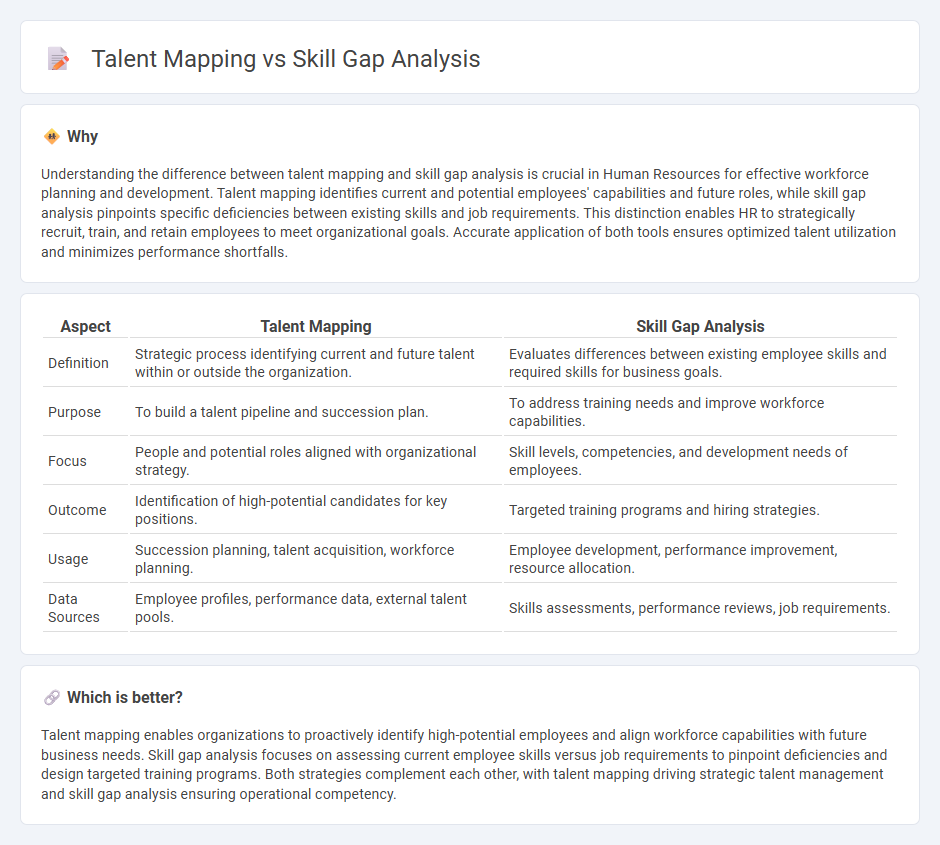
Talent mapping identifies internal and external candidates aligned with organizational goals, while skill gap analysis evaluates discrepancies between current employee skills and those required for future roles. Both processes enhance workforce planning and optimize talent management strategies. Explore how integrating talent mapping with skill gap analysis can drive superior HR outcomes.
Why it is important
Understanding the difference between talent mapping and skill gap analysis is crucial in Human Resources for effective workforce planning and development. Talent mapping identifies current and potential employees' capabilities and future roles, while skill gap analysis pinpoints specific deficiencies between existing skills and job requirements. This distinction enables HR to strategically recruit, train, and retain employees to meet organizational goals. Accurate application of both tools ensures optimized talent utilization and minimizes performance shortfalls.
Comparison Table
| Aspect | Talent Mapping | Skill Gap Analysis |
|---|---|---|
| Definition | Strategic process identifying current and future talent within or outside the organization. | Evaluates differences between existing employee skills and required skills for business goals. |
| Purpose | To build a talent pipeline and succession plan. | To address training needs and improve workforce capabilities. |
| Focus | People and potential roles aligned with organizational strategy. | Skill levels, competencies, and development needs of employees. |
| Outcome | Identification of high-potential candidates for key positions. | Targeted training programs and hiring strategies. |
| Usage | Succession planning, talent acquisition, workforce planning. | Employee development, performance improvement, resource allocation. |
| Data Sources | Employee profiles, performance data, external talent pools. | Skills assessments, performance reviews, job requirements. |
Which is better?
Talent mapping enables organizations to proactively identify high-potential employees and align workforce capabilities with future business needs. Skill gap analysis focuses on assessing current employee skills versus job requirements to pinpoint deficiencies and design targeted training programs. Both strategies complement each other, with talent mapping driving strategic talent management and skill gap analysis ensuring operational competency.
Connection
Talent mapping identifies existing employee capabilities and future talent needs within an organization, creating a comprehensive overview of workforce potential. Skill gap analysis evaluates the differences between current skills and those required for strategic goals, highlighting areas for development. Together, they enable targeted training programs and strategic hiring to optimize workforce effectiveness and align talent with business objectives.
Key Terms
**Skill gap analysis:**
Skill gap analysis identifies the specific skills employees currently lack compared to those required for optimal job performance, enabling targeted training programs and workforce development. This process involves evaluating individual competencies against organizational needs to close performance gaps and boost productivity. Explore how skill gap analysis can transform your talent management strategy.
Competency assessment
Skill gap analysis identifies discrepancies between current employee competencies and required job skills, providing targeted insight into areas needing improvement. Talent mapping evaluates the overall talent pool, aligning employee capabilities with organizational goals to assist in strategic workforce planning. Explore deeper to understand how competency assessments drive both processes effectively.
Training needs
Skill gap analysis identifies discrepancies between current employee capabilities and required job competencies, highlighting specific training needs. Talent mapping evaluates internal and external candidates' skills to align workforce planning with future business goals. Explore detailed strategies to enhance your training programs through effective skill gap analysis and talent mapping.
Source and External Links
Skills Gap Analysis: All You Need To Know - This webpage provides a comprehensive guide on conducting a skills gap analysis, including steps such as defining the scope, identifying needed skills, and creating an action plan.
How to Conduct a Skill Gap Analysis in 2025 (+Template) - This article explains the process of a skills gap analysis, focusing on assessing employee competencies, identifying gaps, and planning upskilling strategies in response to emerging technologies.
How to conduct a skills gap analysis - This tutorial outlines a step-by-step approach to conducting a skills gap analysis, including planning, identifying critical skills, measuring current skills, and acting on the findings.
 dowidth.com
dowidth.com